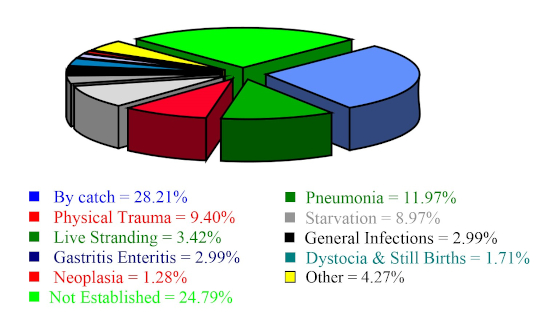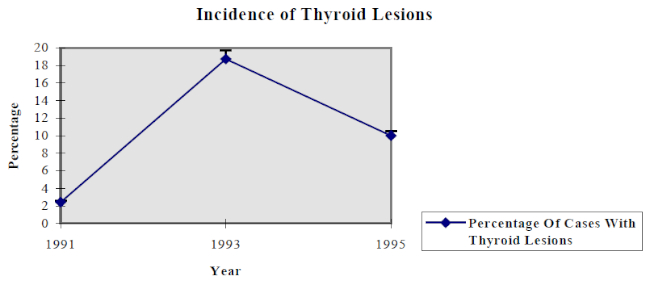A Toxicologic Pathology Study of the Thyroids and Cochleae of Harbour Porpoises (Phocoena phocoena) Exposed to Organochlorines in British Waters: Qualitative Morphopathology, Histomorphometry and Bioanalysis
Horace E. Walcott, DVM, MSPH, MSc
Abstract
A five-phase investigation was conducted to test the hypothesis that there was a significant causal relationship between thyroid lesions and organochlorine concentrations in harbour porpoises (Phocoena phocoena) from British waters, stranded during 1991 and 1995. Double-blind studies were performed on the thyroid sections of 8 out of 28 porpoises: phase I–III. During phase I, qualitative histopathologic evaluations were conducted. Severe, diffuse, chronic fibrotic thyroiditis was diagnosed from the thyroid tissue sections of two porpoises. For phase II, computer-assisted light microscopic histomorphometric (CALMHIM) studies, employing the SEESCAN image analysis system, were conducted on the thyroid sections from three harbour porpoises. The CALMHIM/SEESCAN-derived data were analyzed by the SPSS statistical software: phase III. From the pooled data of the three porpoises, follicular types were defined as:
Megafollicle; inner follicular area (Af)=70489.8±91906.22 µm2; [n=29];
Inner follicular perimeter (ρ)=1651.4±1093.52 µm; [n=29];
Macrofollicle; Af=18122.52±17664.8 µm2; [n=92]; ρ=870.4±116.26 µm; [n=92];
Midminifollicle; Af=7149.1±1464.42 µm2; [n=77]; ρ=413.9±361.96 µm; [n=77];
Microfollicle; Af=2976.5±1332.51 µm2; [n=97]; ρ=283.6±317.82 µm; [n=97].
There was a cubic relationship between the follicular area and follicular perimeter. A statistically significant difference existed between the dimensions of the megafollicle, macrofollicle and microfollicle. There was a negative dose-response relationship between the degrees of fibrosis and colloid depletion, and potentially endocrine disruptive chlorinated biphenyl (CB) concentrations for five porpoises.
Figure 1

A summary of the diagnoses of the etiologies of mortalities for 234 harbour porpoises stranded in the coastal zones of England and Wales, between September 1990 and September 1995.1 The largest percentage of diagnoses were due to the etiologies of by-catch. The non-established diagnoses were the second largest in percentage. Neoplasia in cetaceans has been linked to environmental pollution in the St. Lawrence River, Canada. The endocrine disruptive effects of the CBs would have most likely contributed to a dysthyroid condition in any of these porpoises and contributed to the etiologies of by-catch, physical trauma, starvation, and live stranding.
Figure 2

The incidence of thyroid lesions in harbour porpoises, which were pathologically evaluated between 1991 and 1995 at the London Zoo Hospital. The number of harbour porpoises examined in 1991 was 41. In 1993, 16 harbour porpoises were examined; and in 1995, 20 harbour porpoises were evaluated (n for 1991=41; n for 1993=16; n for 1995=20).
Acknowledgments
Financial support for the author’s postgraduate fellowship in London was provided by Citicorp, the U.S. Department of Education and First America Bank. This project was also supported by a grant from the Zoological Society of London. The author’s gratitude is extended to the Proctor and Gamble Company and the University of Illinois College of Veterinary Medicine and the Study Abroad Office of The University of Illinois at Urbana-Champaign. Without the use of the CALMHIM/SEESCAN apparatus in the laboratory of Dr. Stickland at the Royal Veterinary College, University of London, the study could not have been completed.
Literature Cited
1. Kirkwood, J.K., P.M. Bennett, P.D. Jepson, T. Kuiken, V.R. Simpson, and J.R. Baker. 1997. Entanglement in fishing gear and other causes of death in cetaceans stranded on the coasts of England and Wales. Vet. Rec. 141:94–98.